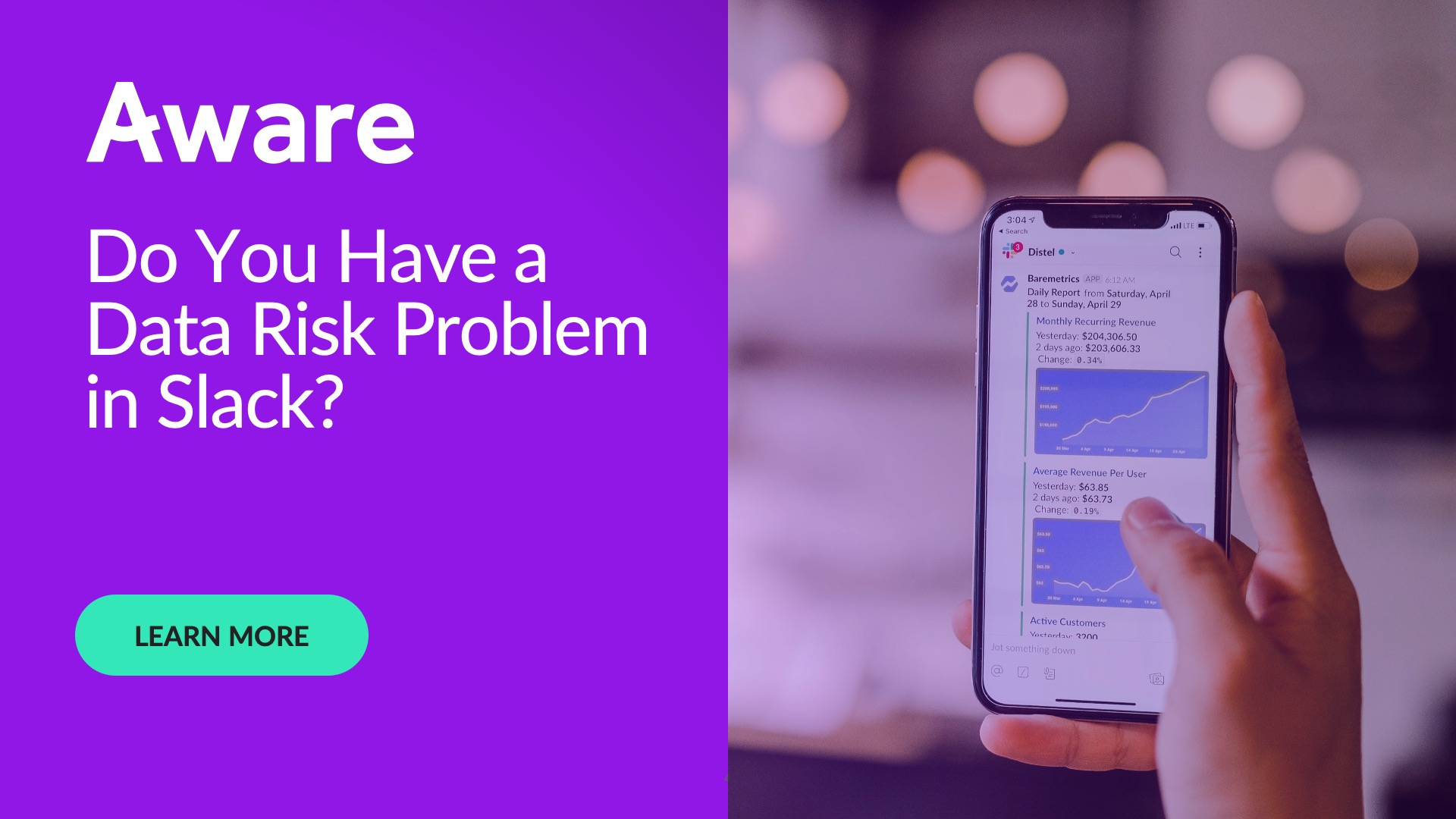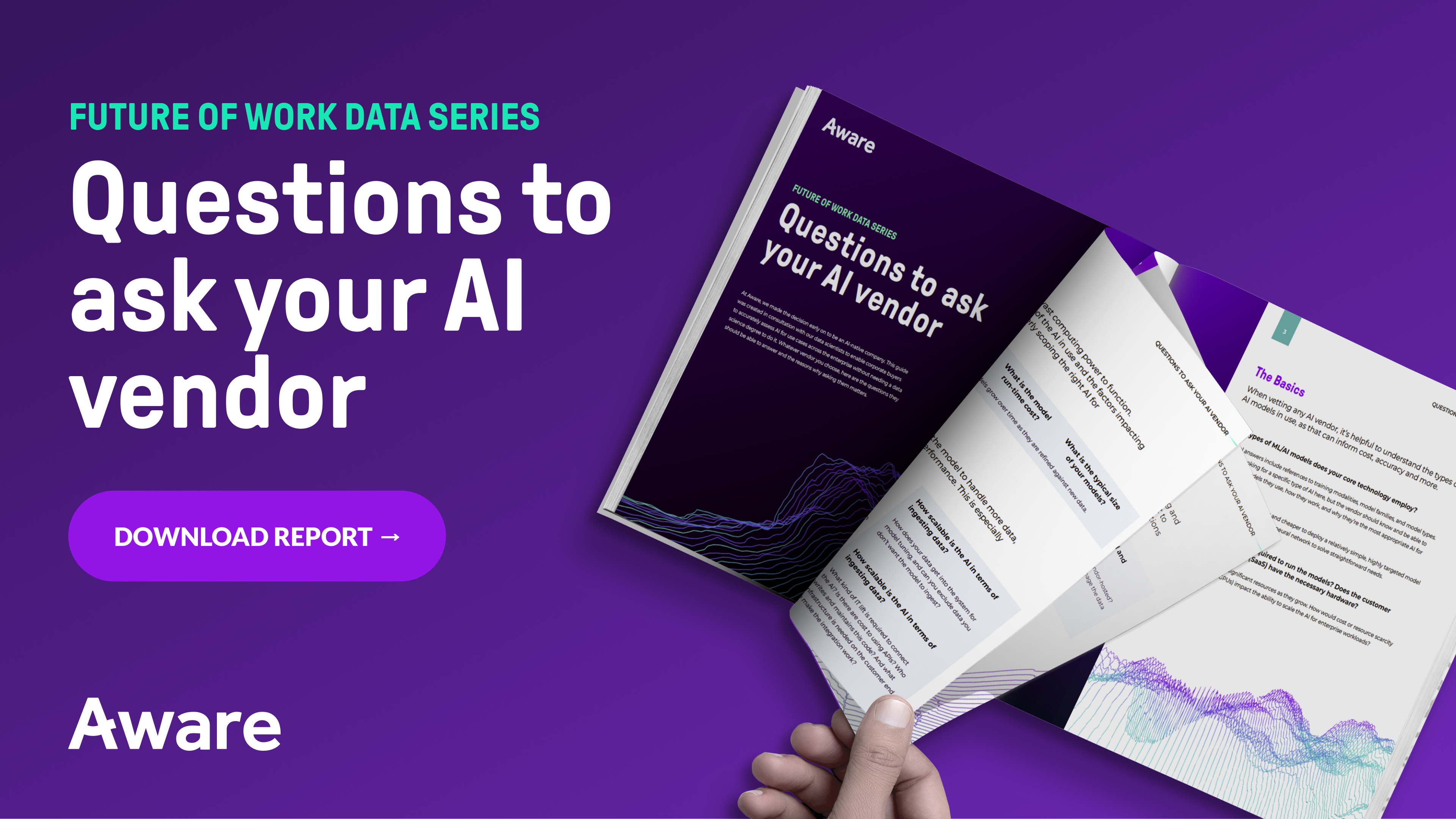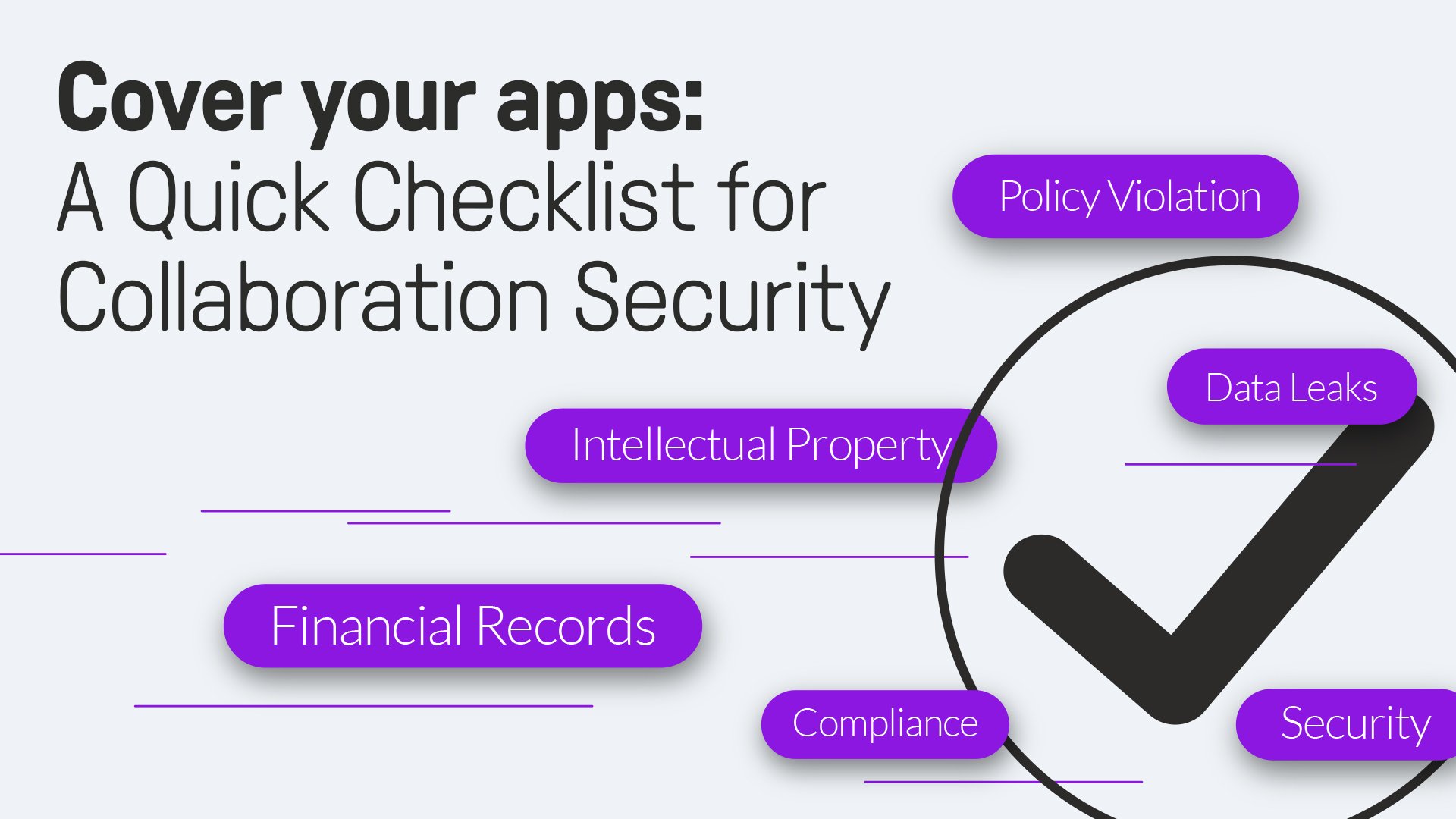Sensitive Data Discovery and Compliance Monitoring for Collaboration
by Aware
Platforms such as Slack, Teams, and Workplace from Meta are indispensable for seamless collaboration in the modern workplace. However, with the convenience of these tools comes the responsibility to manage compliance, particularly regarding sensitive data sharing. Read on to learn more about the challenges associated with compliance in collaboration and explore the importance of sensitive data monitoring and discovery for this data set.
Contents
- Compliance challenges in collaboration
- What types of sensitive data exist in collaboration tools?
- What is sensitive data monitoring and discovery?
- Why is sensitive data protection and monitoring important?
- What types of sensitive data should organizations monitor?
- What are some common methods to discover sensitive data?
- What challenges are associated with sensitive data monitoring?
- How else does sensitive data monitoring work?
- How can organizations minimize false positives in sensitive data monitoring?
- How often should sensitive data monitoring be conducted?
- How does Aware’s sensitive data monitoring help teams manage compliance in collaboration?
Compliance challenges in collaboration
The convenience offered by collaboration tools like Slack, Teams, and Workplace from Meta doesn’t come without risk. The ease of sharing information in real-time can lead to unintentional leaks of sensitive data and present serious compliance challenges that must be addressed. Some areas of concern include:
- Accidental sharing: Employees may inadvertently share sensitive information through messages, files, or screen recordings.
- Malicious activity: Insider threat actors may use the complexity of collaboration tools to hide noncompliant data sharing or exfiltration.
- Shadow IT: Unauthorized use of personal accounts or non-approved tools can bypass security and compliance controls.
- Data sprawl: Unstructured data in collaboration platforms can be difficult to track and manage, increasing compliance risks.

How big a problem is sensitive data in collaboration? Find out now.
What types of sensitive data exist in collaboration tools?
Many kinds of sensitive data proliferate in workplace collaboration tools. These include proprietary company secrets or intellectual property, as well as regulated data such as PII/PHI/PCI. Understanding the scale of the risk you face within collaboration tools, and the extent of sensitive information sharing that occurs in your digital workplace, is critical to putting the right data monitoring and discovery safeguards in place.
- Personally identifiable information (PII): Names, addresses, social security numbers, and other data identifying individuals.
- Protected health information (PHI): Medical records, treatment details, and other healthcare data.
- Payment card information (PCI): Credit card numbers, expiration dates, and other payment details as outlined by the payment card industry data security standard (PCI-DSS).
- Intellectual property (IP): Trade secrets, patents, and other confidential business information.
These data types can be easily shared in messages, documents, and even channel descriptions within collaboration tools. A spreadsheet of employee contact details, or a customer SSN sent in a direct message to expedite a query, can present a significant compliance liability if not addressed.

Case study: How one telecom provider removed 20,000 credit card numbers from collaboration tools.
What is sensitive data monitoring and discovery?
Sensitive data monitoring involves the systematic identification of sensitive information within collaborative platforms. This process is crucial for maintaining compliance standards and preventing data breaches.
For businesses in regulated industries such as finance and healthcare, complying with regulations such as FINRA and HIPAA is mandatory to protect health and financial data. Consequently, compliance leaders must ensure that regulated data shared within collaboration tools is identified and remediated as quickly as possible.
However, even organizations in other industries will handle different types of sensitive and regulated data during the normal course of doing business and should prepare accordingly. For example, employees have the right under the GDPR, CCPA/CPRA, and other data privacy legislation to review all the information that companies hold on them, including from data sources like collaboration tools.
Why is sensitive data protection and monitoring important?
Continuous monitoring for sensitive data is vital to reducing compliance risks in collaboration data sets. When workplaces provide tools like Slack and Teams for employees to use, they must assume that employees will share any and all business-related information within them. The informal nature of collaboration chats can cut through traditional hierarchies and compliance red tape, exposing sensitive information that people know better than to send over email.
Without sensitive data monitoring in place, this information can linger indefinitely within this easily searchable and highly accessible data set where any internal user can find it. Today’s hackers also know that Slack and Teams data is packed with sensitive and compromising information, as both EA Games and Rockstar Games found to their cost when proprietary game footage and data was exfiltrated and leaked from company Slack accounts.
Sensitive data monitoring can help provide real-time visibility into data sharing practices within collaboration tools and promote user awareness of accidental data leaks by alerting employees when sensitive information is detected. Additionally, compliance monitoring in Slack and Teams can provide an early warning of potential data breaches or unauthorized access attempts.
Learn more performing effective content moderation in collaboration tools.
What types of sensitive data should organizations monitor?
Some amount of sensitive information sharing is inevitable in workplace collaboration tools as a matter of doing business. However, companies should be aware of the extent of this information sharing and establish acceptable use policies that outline what is and is not acceptable to share in collaboration.
To reinforce those policies, companies should implement sensitive data monitoring that detects all major kinds of regulated information, as well as set up monitoring safeguards to identify unauthorized sharing of company secrets or other IP. This can include blanket rules like prohibiting file and code sharing in public channels, as well as real-time message analysis using keyword and regular expression (regex) identification.
What are some common methods to discover sensitive data?
Many different tools and processes are available for companies to surface sensitive data sharing. These include SaaS applications, endpoint security and firewalls, and a range of off- and on-premises sensitive data discovery tools and apps that can help companies improve their security posture and accelerate the data discovery process. However, many of these tools were designed for legacy solutions like email and lack the capabilities to handle complex data structures common to collaboration tools. This can leave gaps where threaded conversations, metadata, and other critical data are not captured.
For many companies, the solution involves manually reviewing files, emails, messages, and other electronically stored information (ESI) either as a matter of routine or in response to a particular incident or inquiry. The downside to this process is how inefficient it is, especially in large data sets like collaboration.
Build-in search features can support and enhance the discovery of sensitive data, but often have limited effectiveness. This can be due to message visibility limitations or simply the vast number of different types of sensitive data. Search features may also have varying capabilities to handle spelling mistakes, slang, shorthand, and other common features of collaboration messages.
Employees can support the safeguarding of sensitive data by flagging improper sharing as it occurs. This can help provide a real-time detection system, mitigating potential data leaks. However, as this method is based on user awareness and participation, it can be inconsistent.
What challenges are associated with sensitive data monitoring?
Sensitive data monitoring and compliance in collaboration comes with several challenges. Collaboration tools often have a complex structure of message types and permissions that limit visibility depending on admin level and even account type. Some Slack users, for example, have to petition Slack to access their historical data.
Even when all a workspace’s data is visible, it may not all be available. End users, also known as custodians, retain the ability in collaboration tools to edit or delete their messages bidirectionally, removing or obfuscating evidence of noncompliance in ways that aren’t possible in traditional data sets like email. And the scale of collaboration is like nothing seen before. A workforce of just 100 users will send over 400,000 collaboration messages each year. Manually reviewing this volume of data is impractical for most organizations.
How else does sensitive data monitoring work?
To solve these challenges, organizations rely on advanced technologies such as Artificial Intelligence (AI) and Machine Learning (ML) to analyze collaboration messages in real time. By identifying sensitive data using keywords and regular expressions, these technologies offer a more automated and efficient approach to monitoring for sensitive data.
In addition to detecting keywords and regex, AI/ML models can use natural language processing (NLP) technology to increase the number of relevant search results by better understanding how language is used in collaboration tools. NLP designed for this data set can overcome the complexities of acronyms and shorthand, and even user attempts to bypass security monitoring, delivering enhanced results with more context for greater security and compliance.
How can organizations minimize false positives in sensitive data monitoring?
Minimizing false positives is essential for an effective content moderation and monitoring strategy. Using tools specifically designed for the unique complexities of collaboration data sets, alongside NLP tailored for short-form communication, can significantly reduce false positives. In addition, regularly reviewing and updating monitoring rules can help AI/ML models to learn from the variances of your unique data and improve overall result quality.
How often should sensitive data monitoring be conducted?
For workplace collaboration tools, sensitive data monitoring should be continuous. Employees can use these tools to post, edit, or delete messages around the clock, and that means monitoring must occur 24/7 as well. This ensures that administrators capture a comprehensive picture of information sharing within these platforms, allowing for timely intervention and compliance maintenance.
An ideal solution for collaboration compliance monitoring will ingest messages in real time, capturing a complete record of all revisions and deletions. Batch ingesting messages, even on an hourly basis, creates gaps in the collaboration record that can mask noncompliance or data loss. A malicious insider could share and delete sensitive information, or an employee could upload a file to the wrong channel by mistake and remove the evidence. Both instances, if not captured in real time, can leave compliance and security officers in the dark that an incident occurred.
How does Aware’s sensitive data monitoring help teams manage compliance in collaboration?
Aware supports compliance, data loss prevention (DLP), and eDiscovery in collaboration tools by ingesting and analyzing messages in real time for sensitive and unauthorized information sharing from a central data security platform. Industry-leading, proprietary NLP designed and trained specifically for this data set produces more results with fewer false positives than any competitor, while AI/ML models normalized for each workspace instance deliver contextual understanding of each company’s unique digital environment.

Learn more about the Aware platform
Aware connects natively to all major collaboration tools via API for seamless integration with no impact on the end user. This ensures the capture of a complete record of all messages, including edits and deletions, minimizing vulnerabilities throughout the lifecycle of the data. Aware’s secure platform is restricted through role-based access control to assist in ensuring that personal data is not accessed by unauthorized users. Additionally, Aware’s secure data storage repositories support a range of data governance and data management processes such as bidirectional retention and compliance archiving.
Using Aware, compliance and security teams can augment legacy tools with a continuous compliance solution designed for collaboration data. Aware enables organizations to automate slow, manual processes with outputs that plug into existing workflows to accelerate response times and automatically coach employees on acceptable use policies. By leveraging Aware’s advanced technologies, organizations can navigate the complexities of collaboration while safeguarding sensitive information and maintaining regulatory compliance.











